originally posted at https://canmom.tumblr.com/post/708169...
Animation Night oldtimers - what few remain… - may remember Animation Night 37. It was a fun night where we carved a core through the Lupin III franchise in its many iterations.
For a series of such towering importance to the history of anime, I must have written a massive writeup, right? Ah, if only ‘twere so. Apparently I was having meds trouble - la plus change… - so all you got was a list of films and a promise to write more later.
Well, it’s finally time! Fully two years later x3
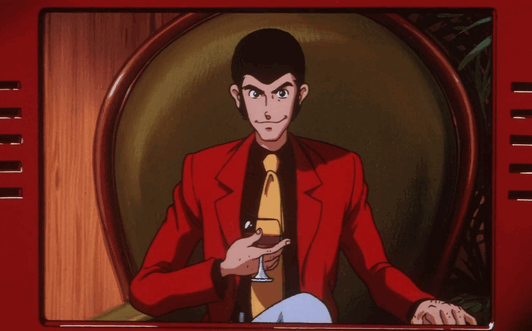
So, Lupin III! It’s a lot of things but before it was any of them, it was a gritty seinen manga by Kazuhiko Katō - far better known by the name Monkey Punch - serialised in a magazine called Weekly Manga Action starting in 1967. Here’s the opening spread…
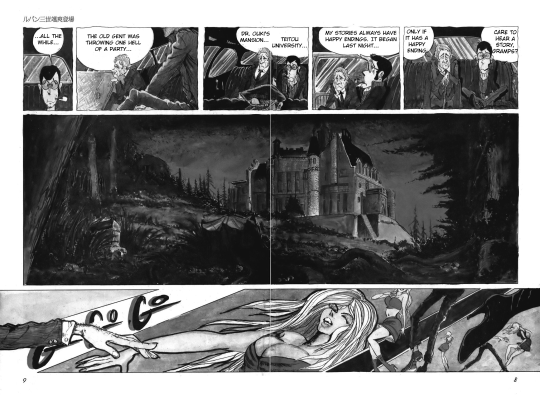
At this time, Monkey Punch was 30, meaning he’d grown up through the second world war, starting his career in comics in junior high where he competed with other artists in the school newspaper. His route into manga was via dōshinshi, then 4koma, and eventually working as an assistant to Naoki Tsuji on influential wrestling series Tiger Mask.
Lupin III took inspiration from, of course, Maurice Leblanc’s stories of gentleman thief Arsène Lupin, by way of a little James Bond. Many of the details of the plot were improvised. Femme fatale Fujiko Mine was originally to be one of a rotating cast of girls like in the Bond films, but that proved to be too much work, so she became a recurring character. Lupin’s samurai buddy Goemon was originally his enemy.
The Lupin manga has that strange horny energy that you tend to expect from 60s manga. It’s definitely still a comedy, but the kind of comedy where the first issue involves microfilm hid inside someone’s vagina and the second has a man almost wrongfully executed. The artwork is sometimes very detaile, but more often sketchy; its expressions are exaggerated, but it predates the codification of standard manga expressions. It’s shaded - in watercolours, I think, and markers. It feels very different from later manga characterised by ultra-precise illustration.
At this point in the history of manga, the waves of gekiga were beginning to be felt. So far as I’m able to tell the distinction goes, Lupin falls outside the (later-defined) line between ‘gekiga’ and ‘manga’, but there was definitely a feeling that more ‘serious’, dramatic stories were coming in. Original flavour Lupin is less ‘thief with a heart of gold’ and more ‘horny trickster’, a much more amoral character.
The manga introduces at first the cat-and-mouse pair of Lupin and Inspector Zenigata, perpetually a step behind. It gradually introduces the rest of the recurring characters: rival thief Fujiko the sexy girl full of cunning plans; Lupin’s partner the gunslinger Jigen whose main trait is shooting really fast and accurate; samurai Goemon whose sword can cut anything, especially clothes.
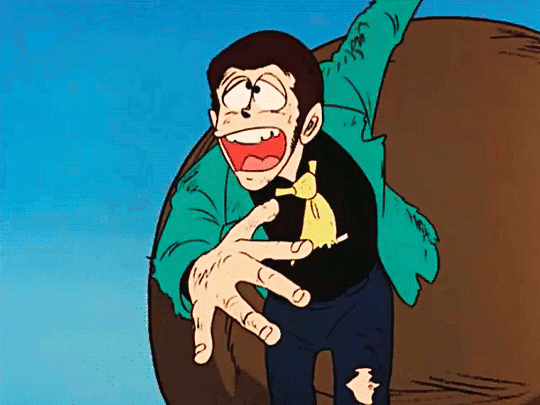
So, the anime then! This is one of those nights where we’re leaning on Matteo Watzky, who’s provided a great deal of information on the production of the original Lupin TV series.
Lupin was only in serialisation for a year when esteemed animator Yasuo Otsuka left Toei in the midst of ongoing union struggles, shortly after the completion of Horus: Prince of the Sun on which he’d worked as animation director. (See Animation Night 70 for more on that!) Otsuka landed at A-Pro, one of a number of studios in the orbit of a company called Tokyo Movie Shinsha, to work on an adaptation of Lupin - at the time, intended to be a feature film under the direction of Masaaki Osumi.
In 1969 they finished a twelve-minute pilot film that steered close to manga in both design and sensibility. Monkey Punch himself provided some supervision. The pilot is a series of brief vignettes introducing the main characters of the manga, with a narrator describing their main traits and fashion choices before brief skits that mostly end in explosions. Its animation is impressively elaborate and stylish and does not look like much from the era, but producers balked at all the sex and violence, so it was retooled into a TV show. Otsuka and Osumi were pulled away to work on Moomin, and the staff shuffled around a lot - not for the last time.
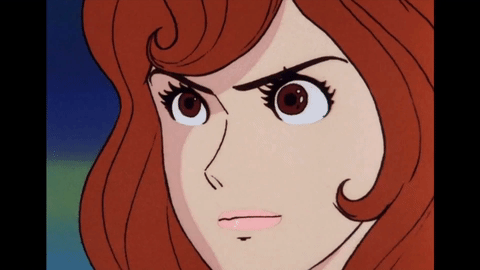
Lupin finally hit TV in 1971, again under Osumi with Otsuka designing characters. It was going for something dark and dramatic by the standards of the time, in the vein of Ashita no Joe (c.f. Animation Night 95) or Star of the Giants. But Osumi’s manga-faithful take hit poor ratings, and when Osumi was unwilling to compromise, he was gradually squeezed off the project.
Instead, Otsuka brought in two of his protégés from the Toei days, recently hot off the collapse of Pippi Longstocking. You may have heard of them. They were of course Hayao Miyazaki and Isao Takahata - at this point an inseparable pair. Although they took over the series, they did a lot of it pseudonymously, and they would leave A-Pro down the line.
The series that resulted under their direction is known to fans as ‘Green Jacket’ Lupin, because (shockingly) Lupin wears a green jacket. It’s full of foreshadowing for Miyazaki’s later works. Osamu Dezaki, also working pseudonymously, directed a number of episodes as well in his distinctive style. Under their direction, the series became a lot lighter in tone, with a gleeful sense of chaos that would become the defining tone of later adaptations. It wrapped up after 23 episodes, with Miyazaki apologising for the stuff - but all in all it was a success, although not as much as the next one would be…
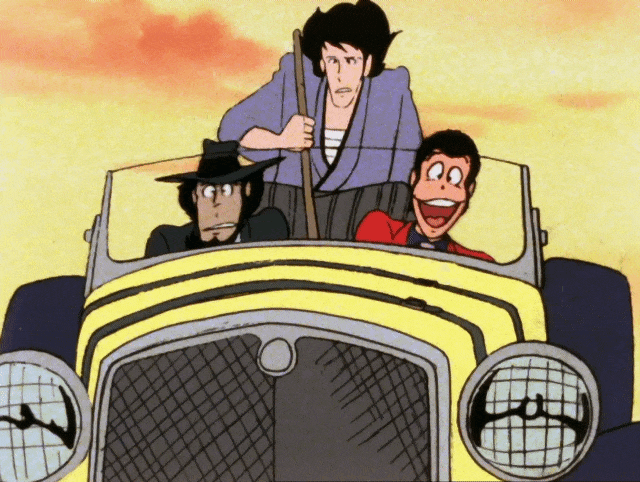
The second Lupin III adaptation, Lupin III Part II known as ‘Red Jacket’ Lupin, came six years later. In this time a great deal had happened. A-Pro had evolved into Shin-Ei and left the TMS orbit, and the other TMS satellites like Madhouse were also going their own way; in such uncertain conditions, and with their own director obsessed with his ultimately fruitless project to adapt Little Nemo In Slumberland, TMS sought to return to some of their various established licenses to make some reliable money.
A very long production that hit 155 episodes, the Red Jacket series is where Lupin really took off. It’s a mixed bag, with plenty of filler, but also several real standout scenes and episodes. In Watzky’s account, much of this has to do with the involvement of Oh Production, a subcontracting studio that would be a close ally of Takahata and Miyazaki right into the Ghibli days. Their star was Kazuhide Tomonaga, known for his work on Space Battleship Yamato, not to mention duelling Yoshinori Kanada to outdo each other in effects for the ridiculously elaborate finale of Galaxy Express 999. Tomonoga’s best moments would come after Miyazaki’s return, but we’ll come to that in a moment.
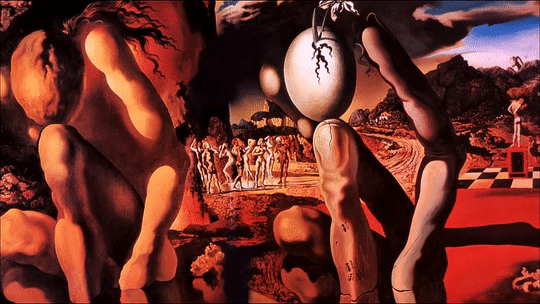
Red Jacket gave rise to the first Lupin movie, The Mystery of Mamo, which served as a vehicle to bring back a lot of the departed Shin-Ei animators into the TMS fold, and prior to Akira, it was the highest budget animated film in Japan with enormous ambitions for animation. Read Matteo’s article to get a sense of the different animators and studios shuffling around, but to summarise very briefly, it brought back most of the staff who had created the pilot film and they were able to bring much of the same energy. The film sets Lupin up against an immortal psychic billionaire, and it features an impressively varied animation style, with manga panels or a dreamlike psychic sequence when Lupin runs through a series of series of surrealist paintings.
Next came… guess what… The Castle of Cagliostro! Miyazaki’s back and he’s going to push his vision of Lupin as a romantic, kind-hearted character to a new level, once again in a green jacket. The film featured startlingly elaborate animation. The car chases cemented Lupin’s car as a staple of the series, the finale features the classic ‘I am a traditional animator and I want to flex’ setting of a gigantic clock full of cogwheels. It’s as fun and impressively shot a film as you’d expect from something headed by Miyazaki, although to Lupin fans, it is widely seen as a frustrating one, since it hews furthest from the ‘proper’ roguish characterisation of Lupin.

Cagliostro is also important for another reason: among otaku, the nascent lolicon movement fixated on its character Clarisse, much as Miyazaki himself had once fixated on the girl Bai-Niang from Toei’s The White Snake Enchantress. That’s a… complicated subject to explicate to put it mildly; I discussed it more on Animation Night 69. ‘Clarisse clones’ started popping up all over the place; Cagliostro was perfectly placed as one of the most impressive animated movies at the dawn of the otaku boom.
The TV series continued to run throughout all this, and the success of Cagliostro washed back in, with sudden character redesigns and of course, the two episodes directed by Miyazaki exhibiting all his quirks. Its scenes feel eerily preminiscent of Ghibli, even more so than Green Jacket, elaborate enough to seriously push the envelope on TV animation.
After all this, Lupin had been firmly cemented as a ‘classic’, nostalgic series in anime. Rather than a single canonical story, it was a group of iconic characters with a general setting and tone that was flexible enough to accommodate many more stories. This probably has a lot to do with its enduring presence: you certainly don’t have to have followed Lupin III from the very beginning to be able to jump in to one of the later installments and have a pretty good sense of what’s going on. There is a comfortable status quo, with Zenigata chasing Lupin who’s always one step ahead; from there, you can pull Lupin and the gang into whatever escapade you have in mind.
Through the 80s and 90s, TMS continued to produce Lupin films with a variety of directors. These generally follow the tone set out by the TV series and they’re a lot of fun. Monkey Punch himself actually directed one, being Lupin III: Dead or Alive, albeit reluctantly at the last minute! The 2000s saw TMS, facing budget limits, stripping production down to OVAs.

The most interesting change of direction came with Sayo Yamamoto, of Michiko and Hatchin and later, Yuri on Ice, who we covered back on Animation Night 36. Reading back her comments in the present, it’s like, wait, that Mari Okada?
In Yamamoto’s hands, the focus shifted from Lupin (though he’s still present) to Fujiko as the main character. The tone hews far closer to Monkey Punch’s manga: sex and violence, sure, but also escapades. It’s a hell of a ride, with all sorts of unexpected tones.
The animation, although clearly taking inspiration from the heavy lines of the manga, is most of all a Koike-ism - the deliberate and weighty way characters move, the use of black, the colour palette all scream ‘I just finished working on Redline for seven years’. Koike would end up staying with Lupin even after Yamamoto moved on, directing a trilogy of hour-long movies, Jigen’s Gravestone, Goemon’s Blood Spray and Fujiko’s Lie.
Last time we did Lupin, we watched one of the three, Goemon’s Blood Spray, last time, and honestly… well it’s a weird one! If Yamamoto’s take was able to preserve the comic chaos even with the darker content, Koike decided to fully go for a drama, with a very strange plot that sees Goemon going on a kind of spirit quest as he’s drawn into an intense battle with first gangsters and then a massive lumberjack guy. The long final battle of the movie sees the two gradually slicing bits off each other, meticulously animated in the way only Koike can (truly I never have seen a more carefully rendered sagittal section of the upper arm muscles), but at the time I found the film struggles to deliver the emotional stakes. It’s a long way from the rest of Lupin, and I’m curious but a little apprehensive to see what Koike did with the other two films.

The other major development in Lupin films is the CG film Lupin III: The First (2019) dir. Takashi Yamazaki (his first animated film), featuring a distinctive stylisation that reminds me most of recent Chinese films like New Gods: Nezha Reborn. It’s a curiously bold departure; it caught my attention with clips of hyperchoreographed action scenes; it’s got a very broad, exaggerated style of movement that’s far from the norm for anime and a constantly roving camera. It’s kind of fascinating to look at, CG that isn’t trying to look like something else. It’s also a departure for the animators at Marza Animation Planet, whose previous works tended to be hyperrealist adaptations such as the 2013 version of Space Pirate Captain Harlock or Kingsglaive: Final Fantasy XV. That’s a lead to follow up on, actually. They would later come to work on the Sonic the Hedgehog films.
So, this movie. It’s evidently attempting to retool Lupin for the CG era, with tributes to the iconography of the old anime, such as remaking Lupin’s car in 3D and staging a chase with it; whether this attempt to ‘modernise’ will land I’m not sure. I don’t love their models for the female characters especially lol, they’re painfully Disney. The plot is a Lupin escapade vehicle with a dash of Indiana Jones, putting Lupin and the gang up against Nazi occultists. I don’t expect it to challenge much, but it does look fun.
So! What’s the plan for tonight?
Well, it’s basically the same plan as last time: another cross-section through the Lupin III series! We’ll hit the following notes:
- the original Lupin pilot!
- The Mystery of Mamo
- Miyazaki’s two episodes of Lupin III Part 2!
- the two parts of Jigen’s Gravestone
- Lupin III: The First
Sound fun? Great! (Doesn’t sound fun? I’ll shoot you.) We’ll be starting early tonight; going live at 7pm UK time, and starting films after about 20 minutes. I’m going to try and keep the start of Animation Night in the 7-8pm range from now on - let’s see if we can rebuild this thing.
If you will, then: head to https://twitch.tv/canmom and get ready for some burglary, robbery, theft, and even perhaps a bit of larceny. See you in the theatre~
Comments